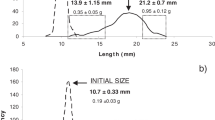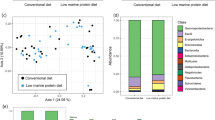Abstract
The rare minnow (Gobiocypris rarus) is a laboratory fish that is commonly used for toxicology research, but there is currently no standard lab diet for this model organism. Certain studies with rare minnows require specialized diets, so there is a need to better understand how manipulating nutrients affects the development and growth of this fish. We conducted two separate dose–response experiments to determine the effect of different levels of dietary protein or dietary lipids on the growth of juvenile rare minnows over 60 d. We measured growth rates and food intake over two periods of time: the first 20 or 30 d of diet consumption and the entire 60 d of each experiment. We found that different levels of dietary protein or dietary lipids produced significantly different growth rates during both the early phase and the entire duration of the study. Among experimental protein-variable diets, those with intermediate levels of dietary protein (around 35.2%) produced the highest growth rate. Among experimental lipid-variable diets, those with intermediate levels of dietary lipids (around 7.6%) produced the highest growth rate. Over all periods of both experiments, however, the control diet of bloodworms generally produced the highest growth rate that matched or exceeded that of any experimental diet. These results can guide investigators when using rare minnows in research, particularly when using custom and standardized diets.
This is a preview of subscription content, access via your institution
Access options
Subscribe to this journal
We are sorry, but there is no personal subscription option available for your country.
Buy this article
- Purchase on Springer Link
- Instant access to full article PDF
Prices may be subject to local taxes which are calculated during checkout




Similar content being viewed by others
References
Yuan, C. et al. Expression of two zona pellucida genes is regulated by 17α-ethinylestradiol in adult rare minnow Gobiocypris rarus. Comp. Biochem. Phys. C 158, 1–9 (2013).
Li, W. et al. Effects of decabromodiphenyl ether (BDE-209) on mRNA transcription of thyroid hormone pathway and spermatogenesis associated genes in Chinese rare minnow (Gobiocypris rarus). Environ. Toxicol. 29, 1–9 (2014).
Goolish, E.M., Okutake, K. & Lesure, S. Growth and survivorship of larval zebrafish Danio rerio on processed diets. N. Am. J. Aquacult. 61, 189–198 (1999).
Matthews, M., Trevarrow, B. & Matthews, J. A virtual tour of the guide for zebrafish users. Lab Anim. (NY) 31, 34–40 (2002).
Lawrence, C. The husbandry of zebrafish (Danio rerio): a review. Aquaculture 269, 1–20 (2007).
Siccardi, A.J. et al. Growth and survival of zebrafish (Danio rerio) fed different commercial and laboratory diets. Zebrafish 6, 275–280 (2009).
Kaushik, S., Georga, I. & Koumoundouros, G. Growth and body composition of zebrafish (Danio rerio) larvae fed a compound feed from first feeding onward: toward implications on nutrient requirements. Zebrafish 8, 87–95 (2011).
Smith, D.L. et al. Dietary protein source influence on body size and composition in growing zebrafish. Zebrafish 10, 439–446 (2013).
Wu, Z.Q., Wang, J.W., Chang, J.B. & Cao, W.X. Studies on biochemical composition of Gobiocypris rarus and its feed. Acta Hydrobiol. Sin. 23, 696–699 (1999).
Chong, A.S.C., Ishak, S.D., Osman, Z. & Hashim, R. Effect of dietary protein level on the reproductive performance of female swordtails Xiphophorus helleri (Poeciliidae). Aquaculture 234, 381–392 (2004).
Ichimura, K. et al. Medaka fish, Oryzias latipes, as a model for human obesity-related glomerulopathy. Biochem. Biophys. Res. Commun. 431, 712–717 (2013).
Leger, P. & Bengtson, D.A. The use and nutritional value of artemia as a food source. Oceanogr. Mar. Biol. Ann. Rev. 24, 521–623 (1986).
Sorgeloos, P., Dhert, P. & Candreva, P. Use of the brine shrimp, Artemia spp., in marine fish larviculture. Aquaculture 200, 147–159 (2001).
Tizol-Correa, R. et al. Fatty acid composition of Artemia (Branchiopoda: Anostraca) cysts from tropical salterns of southern México and Cuba. J. Crustacean Biol. 26, 503–509 (2006).
Yamamoto, T. et al. Influence of dietary fat and carbohydrate levels on growth and body composition of rainbow trout Oncorhynchus mykiss under self-feeding conditions. Fisheries Sci. 67, 221–227 (2001).
Zhang, T.-T., Zhang, Z.-Q., Gao, X.-H., Yang, F.-H. & Xing, X.-M. Effects of dietary protein levels on digestibility of nutrients and growth rate in young female mink (Mustela vison). J. Anim. Physiol. Anim. Nutr. (Berl.) 97, 271–277 (2013).
Shiau, S.-Y. Nutrient requirements of penaeid shrimps. Aquaculture 164, 77–93 (1998).
Webster, C.D. & Lim, C. Nutrient Requirements and Feeding of Finfish for Aquaculture (CABI, Wallingford, UK, 2002).
Wilson, R. Protein and amino acid requirements of fishes. Annu. Rev. Nutr. 6, 225–244 (1986).
Dabrowski, K. Protein requirements of grass carp fry (Ctenopharyngodon idella Val.). Aquaculture 12, 63–73 (1977).
Mazid, M.A. et al. Growth response of Tilapia zillii fingerlings fed isocaloric diets with variable protein levels. Aquaculture 18, 115–122 (1979).
Kaushik, S.J. Nutrient requirements, and supply and utilization in the context of carp culture. Aquaculture 129, 225–241 (1995).
Mohanta, K.N., Mohanty, S.N., Jena, J.K. & Sahu, N.P. Optimal dietary lipid level of silver barb, Puntius gonionotus fingerlings in relation to growth, nutrient retention and digestibility, muscle nucleic acid content and digestive enzyme activity. Aquacult. Nutr. 14, 350–359 (2008).
Wang, J.T. et al. Effect of dietary lipid level on growth performance, lipid deposition, hepatic lipogenesis in juvenile cobia (Rachycentron canadum). Aquaculture 249, 439–447 (2005).
Hillestad, M. & Johnsen, F. High-energy/low-protein diets for Atlantic salmon: effects on growth, nutrient retention and slaughter quality. Aquaculture 124, 109–116 (1994).
Bromley, P.J. Effect of dietary protein, lipid and energy content on the growth of turbot Scophthalmus maximus. Aquaculture 19, 359–369 (1980).
Boonyaratpalin, M. Nutrient requirements of marine food fish cultured in Southeast Asia. Aquaculture 151, 283–313 (1997).
Jauncey, K. The effects of varying dietary protein level on the growth, food conversion, protein utilization and body composition of juvenile tilapias. (Sarotherodon mossambicus). Aquaculture, 27, 43–54 (1982).
American Public Health Association, American Water Works Association & Water Environment Federation. Standard Methods for the Examination of Water and Wastewater 22nd edn. (eds. Rice, E.W., Baird, R.B., Eaton, A.D. & Lenore, S.C.) (American Water Works Association, Denver, CO, 2012).
Shelbourn, J.E., Brett, J.R. & Shirahata, S. Effect of temperature and feeding regime on the specific growth rate of sockeye salmon fry (Oncorhynchus nerka), with a consideration of size effect. J. Fish. Res. Board Can. 30, 1191–1194 (2011).
Yang, H., Cree, T.C. & Schalch, D.S. Effect of a carbohydrate-restricted, calorie-reduced diet on the growth of young-rats and on serum growth-hormone, somatomedins, total thyroxine and triiodothyronine, free T4 index, and total corticosterone. Metab. Clin. Exp. 36, 794–798 (1987).
Desilva, S.S., Gunasekera, R.M. & Shim, K.F. Interactions of varying dietary-protein and lipid-levels in young red tilapia: evidence of protein sparing. Aquaculture 95, 305–318 (1991).
Kolkovski, S., Koven, W. & Tandler, A. The mode of action of Artemia in enhancing utilization of microdiet by gilthead seabream Sparus aurata larvae. Aquaculture 155, 193–205 (1997).
Carvalho, A.P., Araujo, L. & Santos, M.M. Rearing zebrafish (Danio rerio) larvae without live food: evaluation of a commercial, a practical and a purified starter diet on larval performance. Aquacult. Res. 37, 1107–1111 (2006).
Kirk, R.G. & Howell, B.R. Growth rates and food conversion in young plaice (Pleuronectes platessa L.) fed on artificial and natural diets. Aquaculture 1, 29–34 (1972).
McIntosh, D. et al. Culture-independent characterization of the bacterial populations associated with cod (Gadus morhua L.) and live feed at an experimental hatchery facility using denaturing gradient gel electrophoresis. Aquaculture 275, 42–50 (2008).
Wang, J.S., Lin, W.Y. & Simpson, K.L. Assessment of DDT accumulation by brine shrimp (Artemia salina) from filtered water and sewage effluent. Toxicol. Environ. Chem. 61, 15–25 (2008).
Acknowledgements
This study was funded by the National Key Technology R&D Program of China (No. 2011BAI15B01-41). We sincerely thank all colleagues at the Research Group of Fish Physiological Ecology, Chinese Academy of Sciences for their equipment and assistance.
Author information
Authors and Affiliations
Corresponding author
Ethics declarations
Competing interests
The authors declare no competing financial interests.
Rights and permissions
About this article
Cite this article
Wu, B., Luo, S., Xie, S. et al. Growth of rare minnows (Gobiocypris rarus) fed different amounts of dietary protein and lipids. Lab Anim 45, 105–111 (2016). https://doi.org/10.1038/laban.936
Received:
Accepted:
Published:
Issue Date:
DOI: https://doi.org/10.1038/laban.936



